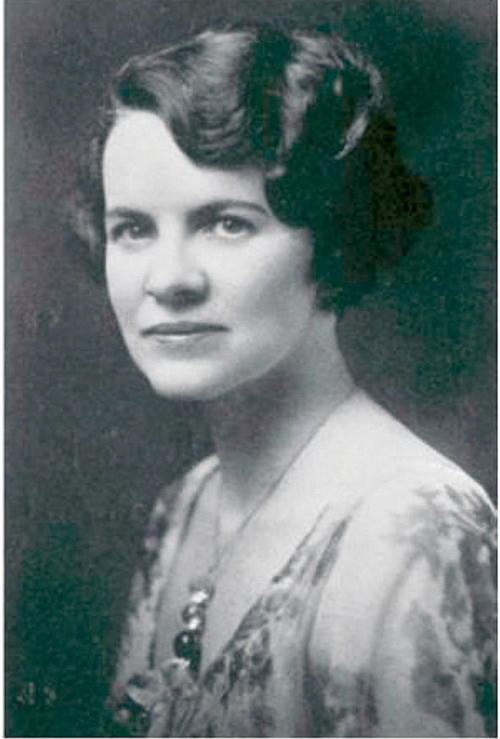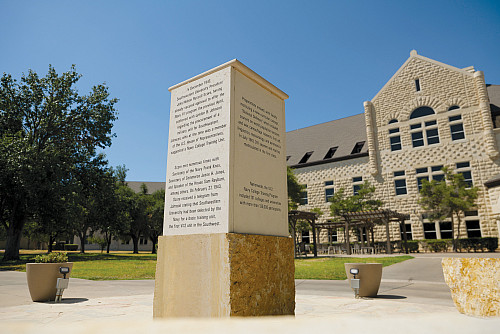News
The Pen and the Sword
U.S. Navy’s V-12 Program Transformed Campus Life in the 1940s
October 27, 2023
October 27, 2023
Open gallery

On March 30, 1938, Pearl Neas wrote a letter of support to a 29-year-old congressman named Lyndon Baines Johnson. That letter had something of a butterfly effect, part of a chain of events that altered the course of Southwestern University.

Johnson would win re-election in 1938 and begin a long friendship with Neas, who served forty years as Southwestern’s registrar. The years following that first letter demonstrate the importance of relationships—personal, professional, and political—in shaping an institution and its people. The interactions of University leaders with Johnson and others in the federal government would lead to the establishment of a U.S. Navy college training program at Southwestern and to the extraordinary transformation of its campus.
Prior to the outbreak of World War II, administrators and faculty at Southwestern dealt with the dual challenges of the Great Depression and the changing social mores of the student body. In his 1973 history of Southwestern, former faculty member Ralph Wood Jones wrote, “there was never a time in the University’s history that changing student habits caused as much consternation and confusion among the administration, faculty, and trustees. Infractions cited included “excessive social functions” and “persistent and pernicious tendencies” to engage in dancing and cigarette smoking. “Charged with being impious, immoral, parent-pampered, fripperous, and grossly materialistic,” Jones wrote, “the students were overtly asserting that they were no longer susceptible to the exhortations of their elders.”
The Winds of War
Not to say there weren’t voices on campus warning of a coming war. Chemistry professor John Godbey told students in a 1937 chapel talk that World War I was not “the war to end all wars” but rather a war to make conditions ready for an even greater conflict. In 1933 Southwestern alumnus Hubert Renfro Knickerbocker, Class of 1917, wrote in the New York Evening Post about the persecution of Jews in Germany and the threat of Nazism to the world and later spoke to Southwestern students about the likely prospect of war.
In September 1940, the same month the U.S. Congress instituted its first peacetime draft, Southwestern added a Civilian Pilot Training program to the curriculum. Although the program had a patriotic flavor, it wasn’t enough to keep students from leaving the University and voluntarily enlisting in the war effort. The University saw enrollment slide from 440 in 1940 to 376 two years later.
In February 1942, just two months after the attack on Pearl Harbor, Methodist minister and former U.S. Army chaplain John Nelson Russell Score became Southwestern’s tenth president. By all accounts, a smart, skilled politician and spellbinding preacher, Score was known for his demanding ways. He was also a cigar-smoking workaholic who threw himself into the work of the University, reorganizing academic divisions and proposing an ambitious modernization of buildings and equipment that would have to be put on hold during the war. Lois Perkins Chapel and Fondren Science Hall, considered Score legacies, were both completed after his death in 1949, but perhaps his greatest legacy was securing the V-12 program during his time at Southwestern.
Return to Pearl Neas, who continued to correspond with LBJ—they would exchange more than two hundred notes and letters during Score’s administration alone. Neas also corresponded with Lady Bird Johnson, who gave Southwestern a series of half-hour radio programs produced at an Austin radio station she owned with her husband. The first program in that series, “Southwestern Builds Americans,” originated in the auditorium of the Administration Building, now the Roy and Lillie Cullen Building.
Score encouraged Neas’ correspondence with Johnson, who regarded the registrar not only as a close friend but also as an unofficial political consultant. “I know of no woman whose judgment I admire more,” Johnson said in 1944.

According to the late William B. Jones, author of To Survive and Excel: The Story of Southwestern University, it is notable that Johnson would address Score and Neas as equals in his correspondence, the three of them frequently communicating as the University geared up to accommodate the V-12 program.
Score met Johnson for the first time in September 1942, seeking ten minutes of the Congressman’s time to request a military unit for his campus. Southwestern had already been approved for a V-1 program, which offered naval education courses to students already enrolled at the University; in essence, it was little more than a student retention program. Fortunately, Score and Johnson hit it off during that first meeting, which stretched from the scheduled ten minutes to more than two hours, after which Johnson, a powerful Naval Affairs committee member, recommended that Score seek a V-12 program for his campus.
While Score went to Washington to make his case to the secretary of the Navy and others, Johnson went to work to seek approval from his own Washington connections. On Feb. 27, 1943, both Neas and Score received telegrams from Johnson informing them of Southwestern’s selection as a site for a V-12 program, the first unit to be established in the Southwest. Ultimately more than 125,000 participants were enrolled in 131 colleges and universities in the U.S. from 1943 to 1946.
Also notable at this time was Johnson’s relationship with George and Herman Brown, founders of the Brown & Root construction company and whose wives, Margarett and Alice, respectively, were Southwestern alumnae. Johnson came to know the Browns through their work on Austin’s Marshall Ford Dam (now Mansfield Dam), as Johnson was instrumental in getting Congress to appropriate funds for the massive project.
The Brown and Johnson families became close friends who shared a mutual love for Southwestern, and when the school was selected as a V-12 site Herman Brown would become vice chair of the Board of Trustees. In 1951 Herman and George would form the Brown Foundation, which would make the single most generous grant in Southwestern’s history.
Wartime Campus
Score seemed well-suited to running a wartime campus, where according to Ralph Jones, “an almost superhuman effort was required to convert the school from a peace-time to a war-time tempo.” By June 28, 1943, the first contingent of sailors assigned to Southwestern began to arrive, and by July, 391 seamen and marines matriculated in the first class.
Seemingly overnight, Southwestern’s enrollment grew to 673, but where to put them? The University had identified Mood Hall, then a men’s dormitory, as housing for recruits, but when an advance team of navy inspectors deemed it unsuitable because it wasn’t fireproof, the University quickly pivoted to Laura Kuykendall Hall, a fireproof women’s dormitory (Kuykendall Hall replaced the Ladies’ Annex, which burned in 1925). Rooms designed for two women were retrofitted to house four V-12 recruits in double bunk beds aboard the “USS Kuykendall.” So where did the women go? They were moved to Mood Hall, where rooms were repainted in pastels, and showers and baths were installed. Whether or not it was made fireproof is unclear.
As for the civilian men who still needed housing, the University purchased the nearby Sherman Hotel, which was renamed Southwestern House. Others were squeezed into fraternity houses or sent into town to find spare rooms. The Navy also required a special store for the V-12 recruits, resulting in the University’s purchase of the Pirate Tavern, which was located across the street from the Administration Building.
Before the recruits arrived on campus, faculty instituted a new curricular concept, “National Defense,” which included courses on world population tensions and war, camouflage research, first aid, linguistics, meteorology, aeronautics, and colloquial Japanese.
Pirate Powerhouse

The war not only bolstered enrollment numbers, it also made Southwestern a national football powerhouse thanks to V-12 recruits drawn from big-time programs. The Pirates’ 1943 roster included seven members from a University of Texas team that had won the Southwest Conference the previous year. Players also came from Baylor (nine), SMU (six), and TCU (four), among others. In 1943 Southwestern defeated the University of Texas in Austin and went on to win the Sun Bowl against New Mexico, finishing the season 10-1-1 and ranked 11th in the final national football poll. The Pirates would repeat as Sun Bowl champions the following year before V-12 recruits returned to their former schools.
The war not only brought the V-12 program to Southwestern; it also prompted the University to purchase the nearby Young Dairy Farm as a hedge against wartime food shortages and rising prices (see next page). The purchase of the 273-acre farm was the beginning of a series of land purchases that now total more than 500 contiguous acres on the east edge of campus. It is on this undeveloped property that the University plans to create a liberal arts-inspired community, a project that will once more transform the campus, again for decades to come.

The war and the V-12 program brought other changes to campus life. A marine recruit from Wichita Falls recounted meeting former heavyweight boxing champion Jack Dempsey, who was a Lt. Commander in the Navy and visited Southwestern as part of a physical training campaign. Matinee idol and Navy Lieutenant Robert Taylor showed up for a troop inspection. Both celebrities were accompanied by Congressman Lyndon Johnson.
In 1945 the V-12 program kicked off its last year at Southwestern, boasting an enrollment of 783, a 108 percent increase over three years. The program helped Southwestern operate in the black and grow its curriculum and faculty, including four noted professors who fled Nazi Germany, among them a concentration camp survivor.
The war was also costly to Southwestern alumni. The lives of sixteen alumni were lost by July 1943, when the first V-12 contingent arrived on campus. In the end, World War II would claim at least thirty-six Southwestern alumni. President Score’s workaholic ways likely cut his life short; he tirelessly toiled through a serious heart condition that would claim him at age 53. As for Pearl Neas, she would continue as registrar until her death in 1962, along the way serving in many leadership capacities for Southwestern. She would also continue campaigning for her friend Lyndon Johnson. In a 1948 letter to Neas, Johnson wrote that he couldn’t think of anyone who had been more consistent and more conscientious in making his progress possible. “I don’t even know how to express my gratitude.”
For those of us who inherit their legacies, we are grateful indeed.
Writer’s Note: Much of the information in this article is based on the late William B. Jones’s seminal history of the University, To Survive and Excel: The Story of Southwestern University, 1840-2000. During his 35-year tenure at Southwestern as the Lucy King Brown Professor of History, Jones was beloved by students and colleagues alike. Following his retirement in 2000, he was given the title of University Historian.
















